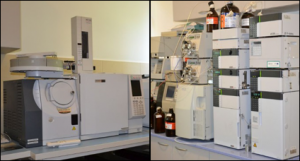Health-promoting compounds in livestock
In response to consumer demands, as well as government regulations, today’s intensive farm animal industry must adapt to producing ruminants without antibiotic growth promoters. Because there is no alternative as effective as antibiotics, a combination of breeding strategy and feed additives can be used to achieve good gut health, growth performance, and appropriate quality of edible parts of the farm animal’s carcass.
One of the specialties of the KIAP&N in Jabłonna is the study of the protective effects of dietary selenium (Se, an essential component of glutathione peroxidases), lycopene, tocopherols, and phenolic species on the deposition of essential elements, vitamins, health-promoting fatty acids (e.g. CLA isomers or W-3 long-chain polyunsaturated fatty acids, W-3 PUFA), and on oxidative stress in the body of ruminants.
Recent studies show that W-3 PUFA reduce inflammation and can help lower the risk of chronic diseases such as heart disease, arthritis and cancer. W-3 PUFA are highly concentrated in the brain and appear to be important for cognitive (brain memory and performance) and behavioural function. Infants who do not get enough W-3 PUFA from their mothers during pregnancy are at risk of developing vision and nerve problems. Symptoms of W-3 PUFA deficiency include fatigue, poor memory, dry skin, heart problems, mood swings or depression, and poor circulation. On the other hand, most W-6 PUFA tend to promote inflammation. Unfortunately, the typical western diet tends to contain a high level of saturated fatty acids as well as 14-25 times more W-6 PUFA than W-3 PUFA, which many nutritionally oriented physicians consider to be much too high on the W-6 side.
Professor Marian Czauderna and his research group from the KIAP&N have recently been interested in laboratory simulation of factors stimulating the exchange and circulation of trace elements, based on the study of the bio-distribution of Se and heavy metals. They have therefore focused on improving analytical procedures and chromatographic methods employed for determination of purine metabolites, elements, fatty acids, tocopherols, cholesterol and its oxidation products, indexes of bacterial mass and oxidative stress, as well as protein and free amino acids in biological samples. Moreover, liquid and gas-chromatographic methods for quantifying short and long-chain fatty acids, with special emphasis on conjugated fatty acids, have been developed. The methods of photodiode detection and mass selective detection were optimised. This particularly applies to the accuracy, precision and selectivity of the developed methods. Their studies concern the digestion and metabolism of nutrients in forestomachs, as well as recycling of nitrogen compounds in the rumen and body of ruminants (cows, sheep, and goats). The main objectives of current in vitro and in vivo studies are to investigate the metabolism of amino acids (especially essential amino acids), W-3 PUFA, and CLA isomers in both the ruminal fluid and livestock carcasses.
Professor Czauderna’s group participated in the scientific consortium ‘BIOFOOD – innovative, functional products of animal origin’ (No. POIG.01.01.02-014-090/09), the Polish-Czech joint research project; grants funded by the State Committee for Scientific Research and the National Science Centre). They have shown that dietary Se, plant and fish oils positively modify the profile of health-promoting fatty acids, as well as reducing the level of harmful oxidised species in the edible parts of carcasses of farm animals. Moreover, the optimal health-promoting levels of lycopene and different chemical forms of Se added to the diets of farm animals have been established; this is important information for nutritionists carrying out investigations to improve the nutritive value of food for human health. His studies on laboratory animals also revealed that dietary CLA isomers (particularly cis10trans12CLA) reduce the content of fatty acids and stimulate the accumulation of amino acids (and thus proteins), especially essential amino acids, in the muscles of monogastric animals. Finding that selenate and some selected CLA isomers fed to monogastric animals considerably increase the level of Se, Zn, CLA isomers, non-CLA fatty acids containing double bonds (anabolites of dietary and endogenic CLA isomers) and other PUFA in the muscles of laboratory animals is valuable information for physiologists.
Future participation of the KIAP&N as a partner in the projects of Horizon 2020 would have significant effects on its scientific activities and raise the prestige of the institute in the country and across the EU.
Professor Tomasz Misztal
Director
The Kielanowski Institute of Animal Physiology & Nutrition
Instytucka 3 Street,
05-110 Jabłonna n. Warsaw,
Poland
tel: +48 (22) 765 33 01
Fax: +48 22 765 33 02
[email protected]
www.ifzz.pl

